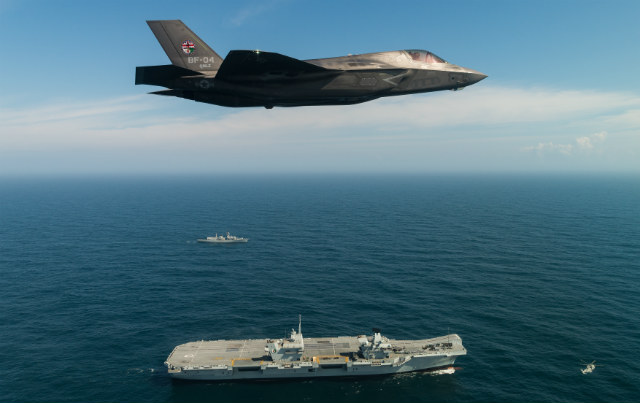By Richard Scott
After more than a decade of study, experimentation, modelling and simulation, the UK has successfully completed a first phase of testing using a shipborne rolling vertical landing (SRVL) manoeuvre for the Lockheed Martin F-35B on board the Royal Navy’s new aircraft carrier, HMS Queen Elizabeth.
Fifteen SRVL recoveries were performed using integrated test force (ITF) development aircraft BF-04 and BF-05 during the two periods of development testing (DT-1/DT-2) during the ship's recent first-of-class flight trials. Pilots and test engineers from the ITF embarked for the activity confirm that initial testing validated simulations and has given confidence in the innovative manoeuvre.
An SRVL recovery exploits the ability of the short take-off and vertical landing F-35B to operate in a semi-jetborne mode. Forward speed maintains airflow over the aircraft surfaces, providing additional wingborne lift to augment thrust from the Pratt & Whitney F135 engine, allowing it to land at weights significantly above the aircraft’s maximum hover limit.
While a vertical landing is still intended to be the primary recovery mode for the F-35B on board the RN’s two Queen Elizabeth-class carriers, the size and arrangement of the vessels' flightdecks enables SRVL to be employed as an alternative, offering a significant increase in "bring-back" payload.
This will be most valued when the F-35B is recovering with external stores, particularly in hot weather/low pressure conditions, where vertical recovery margins are narrowed. The UK's previous-generation BAE Systems Harrier was often required to ditch ordnance before making a vertical recovery under such conditions.
Other benefits of the SRVL manoeuvre include reduced deck wear, extended engine life and reduced fuel burn.
When executing an SRVL recovery, a pilot descends the aircraft to a 200ft plateau to line up and decelerate, before flying short finals along a 7˚ glideslope at a speed of approximately 60kt (110km/h). Assuming 25kt wind over the deck, this equates to a 35kt overtake speed. The pilot can fly a manual approach or engage "Delta Flight Path" mode to automatically fly the glideslope with minimum intervention.

Crown Copyright
However, an SRVL recovery presents some inherent risk, given that the F-35B must approach the ship from aft using a precise glideslope and speed. Once on deck, the aircraft must use its own brakes to come to a stop.
A ship-referenced velocity vector is incorporated in the pilot's helmet-mounted display, to provide a flightpath marker corrected for ship speed. HMS Queen Elizabeth is also equipped with an SRVL-specific visual landing aid, in the form of a mini fixed array of lights in the flightdeck tramlines, which provides a stabilised glideslope indication.
The SRVL manoeuvre also requires close co-operation with the ship's landing signal officer (LSO) in the flying control tower, or "FLYCO". The LSO monitors the aircraft's approach to the deck to check that glideslope, airspeed, attitude and line-up remain within parameters.
BAE Systems F-35 STOVL test pilot Peter Wilson on 13 October became the first ITF pilot to recover to Queen Elizabeth using the SRVL manoeuvre. He had previously flown over 2,000 simulated recoveries using a full-motion simulator at the company's ship/air integration facility in Warton, Lancashire.
"In my view, this is the way to land that airplane on this carrier, because it gives you so much capability," he says. "At this point, if you want me to go and land an F-35B on Queen Elizabeth, I’m going to do an SRVL."
RN Cdr Nathan Gray, another of the ITF test pilots involved in DT-1/DT-2, observes that flight testing has proved the SRVL to be a benign manoeuvre, and suitable for fleet pilots. "It represents our biggest win from this test from an experimental point of view," he says. "SRVL will give us somewhere between 2,000lb and 3,000lb [880-1,320kg] of extra bring-back, which is phenomenal for a STOVL aircraft."
The 15 SRVL recoveries flown during DT-1/DT-2 were designed to demonstrate initial manoeuvre capability and gather evidence to validate prior simulations. "Throughout that initial demonstration, we've shown very good robustness to all the clearances, all the loads, all the handling qualities," says Martin Peters, BAE's F-35 flight-test manager and STOVL test lead. "It’s all been very good, and it looks like we've got a platform that is absolutely viable. What we will look to do next year [in DT-3] is expand that envelope."

Crown Copyright
Maximum bring-back still has to be established. Real-world data captured during DT-1/DT-2 will be fed back into laboratory models and the Warton simulator. "We’ll refine the models based on the real-world use cases [and] start to extrapolate from there," Peters says.
While the UK is currently the only F-35B operator planning to utilise the SRVL recovery, the US Marine Corps has also shown interest in the manoeuvre.
Source: FlightGlobal.com



















